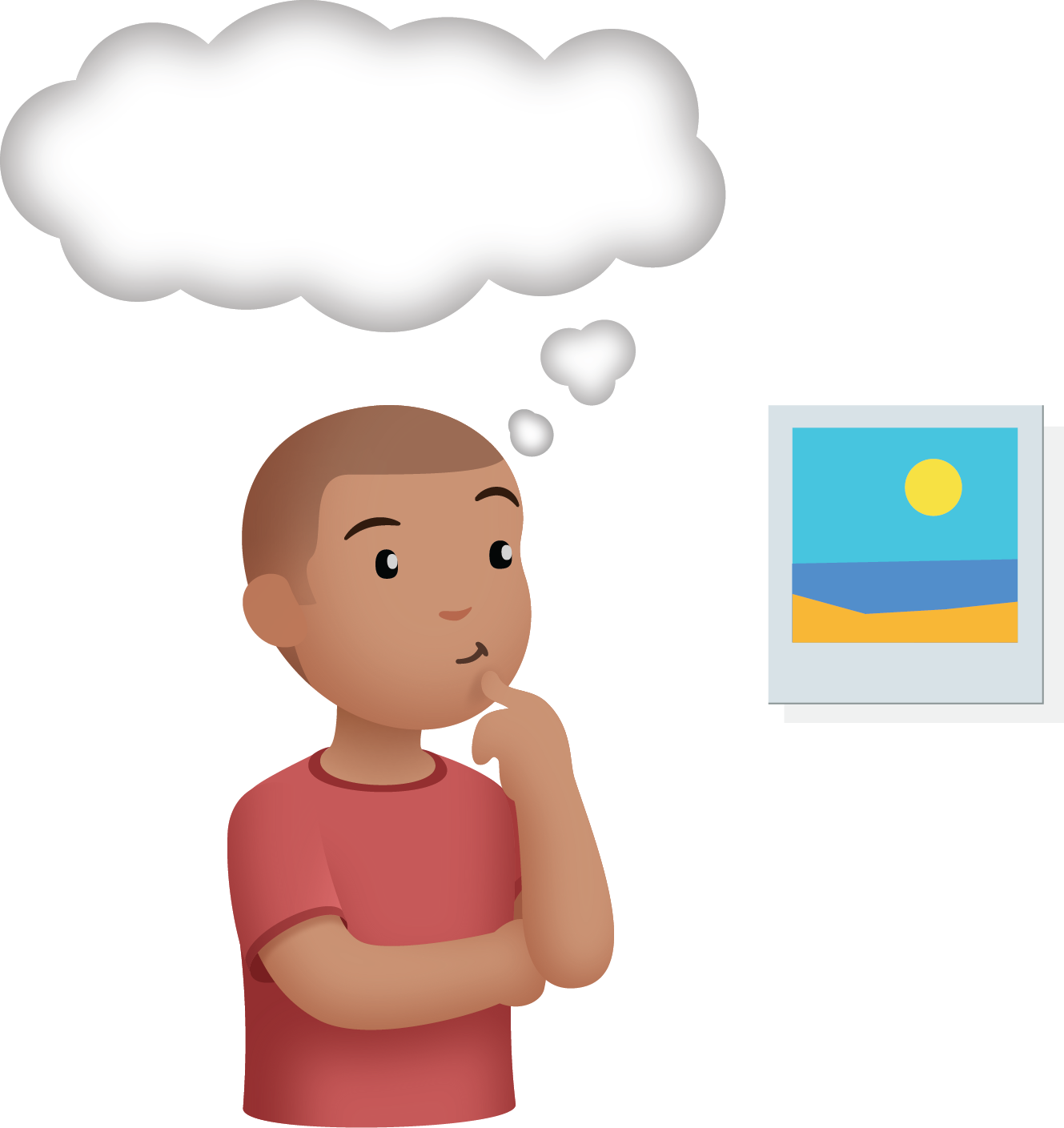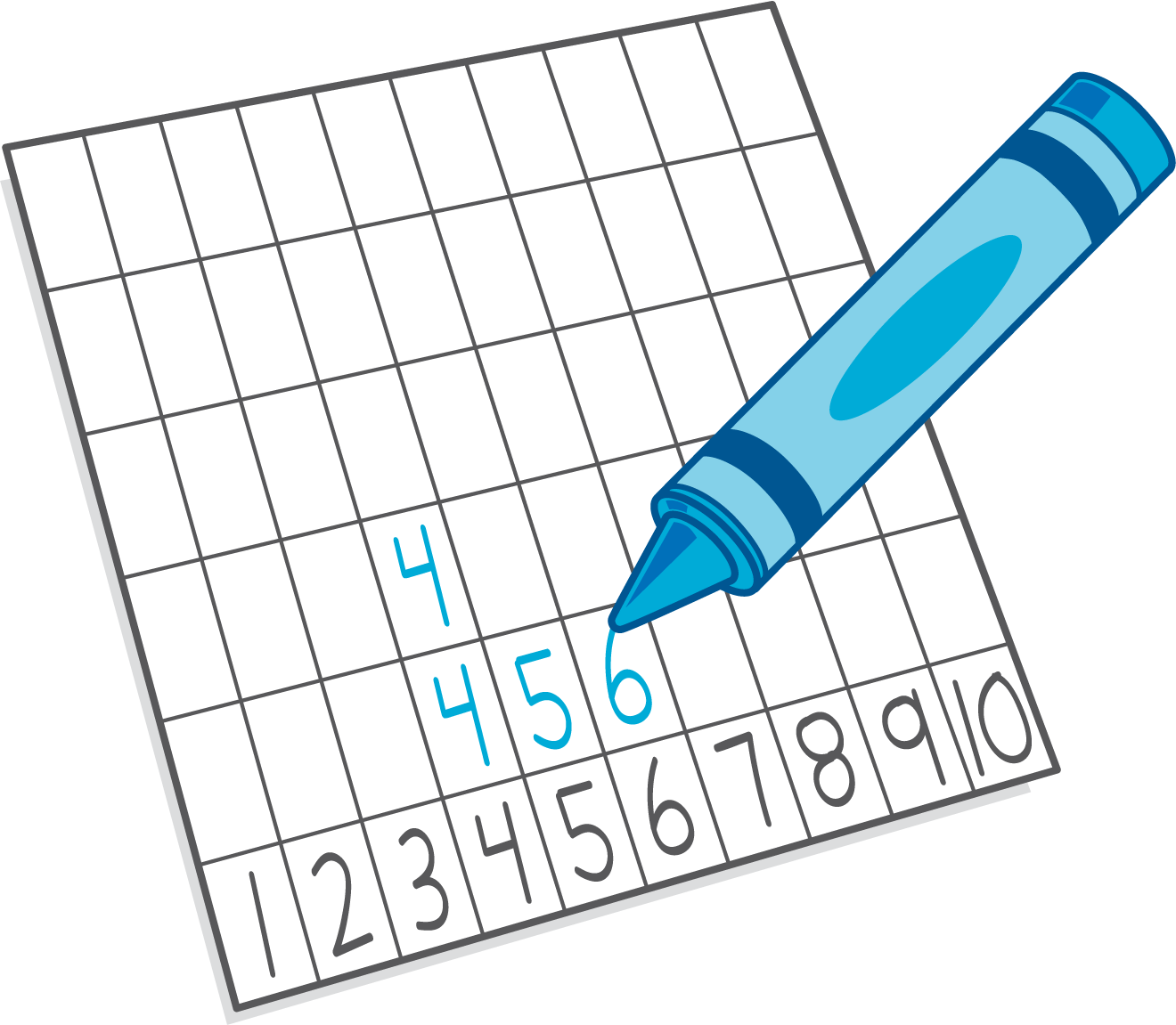Lesson 11
Create Groups of Images
Warm-up: Questions About Us: Slide or Swings? (10 minutes)
Narrative
The purpose of this warm-up is for students to consider concepts of number in a familiar context. Students compare groups of images in the synthesis. Adjust the context to better reflect students’ interests and experiences as needed. For example, the question can be adjusted to ask students to choose between two types of playground equipment that are available at school or in the community where students live. A question can also be chosen from the list that students generated in a previous lesson.
Required Materials
Materials to Copy
- Questions About Us Chart
Launch
- Groups of 2
- Display the Questions About Us Chart.
- “Would you rather play on the slide or on the swings?”
- 30 seconds: quiet think time
- Record each student’s choice with a circle in a 5-frame.
Activity
- “How can we figure out how many students would rather play on the slide?”
- 30 seconds: quiet think time
- 30 seconds: partner discussion
- Share responses.
- Demonstrate or invite students to demonstrate counting.
- “How many students would rather play on the slide?”
- If needed, ask, “How can we figure out how many students would rather play on the swings?”
- 30 seconds: quiet think time
- 30 seconds: partner discussion
- Share responses.
- Demonstrate or invite students to demonstrate counting.
- “How many students would rather play on the swings?”
Student Response
For access, consult one of our IM Certified Partners.
Activity Synthesis
- “Did fewer people choose the swings or the slide? How do you know?”
Activity 1: Draw Groups of Images (10 minutes)
Narrative
The purpose of this activity is for students to draw groups of images that have more, fewer, or the same number of images as a group drawn by their partner. Students use comparison language as they describe the group their partner should draw. The synthesis builds on an idea introduced in the previous lesson. Students see that when creating a group that is more than another group, you first have to make the same amount and then add more (MP8).
Supports accessibility for: Memory, Organization
Launch
- Groups of 2
- “You are going to draw a group of things. Then show your group to your partner and say one of the sentences.”
- “Draw a group that has more things than my group.”
- “Draw a group that has fewer things than my group.”
- “Draw a group that has the same number of things as my group.”
- “Your partner will draw a group next to yours, tell you how many things are in the group, and say a sentence using ‘more’, ‘fewer’, or ‘the same number’.”
- “Switch roles and repeat.”
Activity
- 5 minutes: partner work time
Student Facing
| my group | my partner's group |
|---|---|
| my group | my partner's group |
|---|---|
Student Response
For access, consult one of our IM Certified Partners.
Advancing Student Thinking
If students draw a group that doesn't match the direction their partner gave them, consider asking:
- “Tell me about the directions that your partner gave you.”
- “Can you draw a group that has the same number of things? How can you change this group so that it has more/fewer things?”
Activity Synthesis
- Display 4 circles.
- “I need to draw a group of things that has more than this group.”
- Draw 2 circles.
- “Does this group have more things? How can you tell?” (No, I know 2 is less than 4.)
- Draw 2 more circles.
- “Does this group have more things? How can you tell?” (No, they both have 4 circles so they are the same.)
- Draw 1 more circle.
- “Does this group have more things? How can you tell?” (Yes, because they both have 4, but your group has 1 more.)
- “What if I drew another circle?” (You would still have more. You could keep drawing as many circles as you want and you will always have more than 4.)
Activity 2: Introduce Less, Same, More, Drawings (15 minutes)
Narrative
The purpose of this activity is for students to learn stage 3 of the Less, Same, More center. Students draw groups that have more, fewer, or the same number of images as a given group. Consider using a sheet protector or laminating the mats for students to use with dry erase markers. Otherwise, make multiple copies of the mats for each group.
Advances: Listening, Speaking
Required Materials
Required Preparation
- Each group of 2 needs a set of cards from the blackline master.
Launch
- Groups of 2
- Give students the mats and cards.
- “We are going to learn a new way to play the Less, Same, More center. It is called Less, Same, More, Drawings.”
- “First, draw a card and place it at the top of the mat. Figure out how many things are on the card.”
- Point to each square as you explain: “Draw three groups in the squares below. Draw one group that has fewer things, one group that has the same number of things, and one group that has more things.”
- “Switch mats with your partner. Check to be sure you agree with the groups your partner made.”
- “Choose one of the groups you drew to describe with a sentence using ‘more,’ ‘fewer,’ or ‘the same number’.”
- “When you are finished, place a new card at the top of your mat and draw groups that have more, fewer, and the same number in the squares.”
Activity
- 10 minutes: partner work time
Activity Synthesis
- Display the card with 5 dots in a number cube arrangement:
- “Draw a group that has fewer images.”
- 1 minute: independent work time
- “How many images are in the group you drew?”
- Share responses.
- “Did all of our groups have the same number of things? Why?” (No, some people drew groups with 2 things and some people drew groups with 4 things. 4 and 2 are both less than 5.)
- “Did all of our groups have fewer than 5 things?” (Yes.)
Activity 3: Centers: Choice Time (20 minutes)
Narrative
The purpose of this activity is for students to choose from activities that offer practice counting and comparing groups of objects and images.
Students choose from any stage of previously introduced centers.
- Less, Same, More
- Bingo
- Math Stories
- Connecting Cubes
- Number Race
Required Materials
Materials to Gather
Required Preparation
- Gather materials from:
- Less, Same, More, Stages 1-3
- Bingo, Stage 1
- Math Stories, Stage 1
- Connecting Cubes, Stages 1-3
- Number Race, Stage 1
Launch
- “Today we are going to choose from centers we have already learned. You can also continue playing Less, Same, More."
- Display the center choices in the student book.
- “Think about what you would like to do first.”
- 30 seconds: quiet think time
Activity
- Invite students to work at the center of their choice.
- 8 minutes: center work time
- “Choose what you would like to do next.”
- 8 minutes: center work time
Student Facing
Choose a center.
Less, Same, More

Bingo

Math Stories

Connecting Cubes

Number Race

Activity Synthesis
“Tell your partner one way they were a good partner today. Give your partner one suggestion for the next time we work with partners.”
Lesson Synthesis
Lesson Synthesis
“Today we made groups with more, fewer, or the same number of things as another group.”
Draw or display:

and

“Tell your partner how you would figure out which group has fewer dots.” (I would count each group and see which has more. I see 5 and 2 more in the first group so I would count 5 in the second group and see if there were 2 more. 7 is more than 6.)
Draw or display:

“Tell your partner what you would do if you had to make a group with fewer dots.” (I would draw 5. I know 5 is fewer because there wouldn’t be any dots under the 5-frame.)
Cool-down: Unit 2, Section B Checkpoint (0 minutes)
Cool-Down
For access, consult one of our IM Certified Partners.
Student Section Summary
Student Facing
In this section, we counted many different groups of things.
We kept track of which ones we counted to make sure that we only counted each thing one time.
We also compared the number of things in groups using “more”, “fewer”, and “the same number.”
Sometimes we could just see that there were more.

Sometimes we had to match or count to figure out which group had fewer.


6 dots is fewer than 7 dots.
